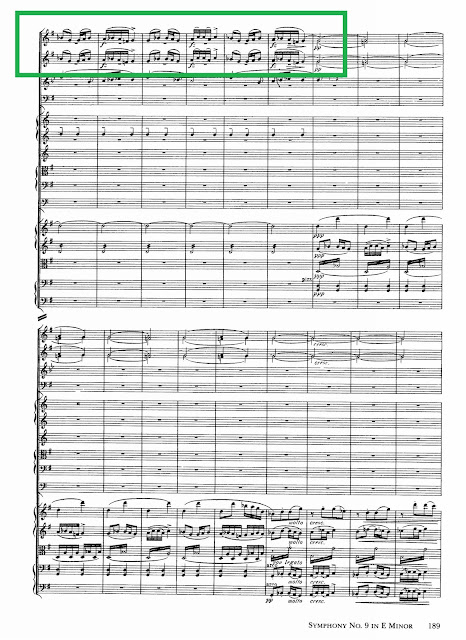CDXCVIII. DVOŘÁK, Antonin (1841-1904)
The confusion in the numbering of Dvořák's symphonies stems from the fact that the first four were not published until after the final five.
Here -- on this magnificent title page -- we can see that this was #8, as Dvořák didn't consider #1 good enough to make the list.
**
He spent three years in America -- 1892-95 -- where he was director of the National Conservatory of Music in New York at the astounding salary of $15,000.
Founded in 1885 by Jeannette Meyers Thurber, a remarkable woman, who modeled her institution after the Paris Conservatory. She made scholarships available to people of color, women and the disabled.
It was here that Dvořák met the 24-year-old Black student, Harry Burleigh, who was earning his tuition by mopping the floors. Burleigh frequently sang negro spirituals while he was working, and soon Dvořák found himself transfixed by American Negro music.
That he incorporated his love of Black music into this symphony will be pointed out below, but a quote will provide a demonstrative prologue:
It was here that Dvořák met the 24-year-old Black student, Harry Burleigh, who was earning his tuition by mopping the floors. Burleigh frequently sang negro spirituals while he was working, and soon Dvořák found himself transfixed by American Negro music.
That he incorporated his love of Black music into this symphony will be pointed out below, but a quote will provide a demonstrative prologue:
"In the negro melodies of America, I discover all that is needed for a great and noble school of music."
First movement
This little introductory motif sets the stage for the coming Allegro:
The exposition contains three different themes. Here's the first, principal one. Dvořák isn't shy about its repetition:
This third theme -- solo flute -- bears a passing resemblance to the Negro spiritual "Swing Low, Sweet Chariot."
Dvořák develops all these themes, changing keys, and brings it all home in a tutti Coda with the trombones blaring out the main theme:
Second movement
This famous theme in the distant key of D-Flat Major is played by the English Horn -- Dvořák is said to have been inspired by Burleigh's beautiful voice:
which turns funereal with pizzicato bass accompaniment:
A little scherzo-like section (eight bars) serves as an interlude before Dvořák returns to the main theme:


Third movement
A clever theme, created with stretto:
A gentle trio in the parallel major (E) slows things down:
After the repeat, a Coda reintroduces the main theme in the horn, and brings the movement to a conclusion:
Fourth movement
A second theme is played by the clarinet above tremolo strings:
Dvořák weaves in virtually all of the previous themes in the development. All is finished, and the ending suggests the usual sforzando chords ... but wait! Dvořák has one more surprise up his sleeve -- an unexpected diminuendo on the final chord ... diminished triumph.























No comments:
Post a Comment